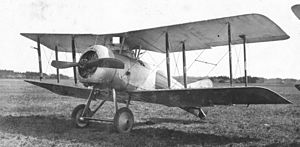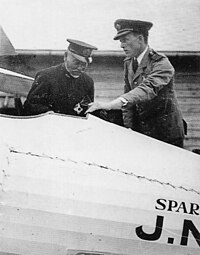Gloster Sparrowhawk
| Sparrowhawk | |
|---|---|

| |
| Role | Fighter |
| Manufacturer | Gloster Aircraft Company |
| Designer | Henry Folland |
| First flight | 1921 |
| Introduction | 1921 |
| Retired | 1928 |
| Primary user | Imperial Japanese Navy |
| Number built | 91 |
| Developed from | Nieuport Nighthawk |
| Variants | Gloster Grouse |
The Gloster Sparrowhawk was a British single-seat fighter aircraft of the early 1920s. A development by Gloster Aircraft Company of the earlier Nieuport Nighthawk fighter, 50 aircraft were built by Gloster for the Imperial Japanese Navy, with a further 40 being assembled in Japan, being operated from 1921 to 1928.
Development and design[]

When the British aircraft manufacturer Nieuport & General closed down in 1920, the services of its chief designer, Henry Folland were hired by the Gloster Aircraft Company, who also acquired the rights for Nieuport's Nighthawk fighter, a promising design that had been ruined by the use of the unreliable ABC Dragonfly radial engine. Folland used the Nighthawk as the basis for a series of developments known as the Gloster Mars series, with both air racer and fighters being produced.[1] When, in 1921, Britain sent the Sempill Mission to Japan to allow the Japanese to develop a Naval Air Arm, Gloster was able to meet the requirements of the Imperial Japanese Navy for a single-seat fighter by a modification of the Nighthawk.[2][3]
The resulting Sparrowhawk was made from existing stocks of stored Nighthawk components, but replaced the Dragonfly with the Bentley BR2 rotary engine, allowing Japan's order for 50 Gloster built aircraft and a further 40 in component form for manufacture at the Yokosuka Naval Air Technical Arsenal to be quickly met. Of the 50 Gloster-built Sparrowhawks, 30 were Sparrowhawk I land based fighters, ten Sparrowhawk II twin-seat advanced trainers and the remaining ten completed as Sparrowhawk III shipboard fighters. The Sparrowhawk IIIs, which were similar to the 22 Gloster Nightjar carrier fighters produced to operate from the Royal Navy's aircraft carriers, were fitted with appropriate flotation equipment and arrestor gear.[4] The 40 Yokosuka assembled aircraft were completed as Sparrowhawk Is.[2]
A single additional Sparrowhawk II was built by Glosters as a civil demonstrator. This aircraft, registered G-EAYN flew in the 1922 Aerial Derby around London, and was later converted to form the prototype Gloster Grouse.[5]
Operational history[]
The Sparrowhawk entered service with the Japanese Navy in 1921, with the ten Sparrowhawk IIIs being used for flight training operations from ramps built on one of the gun turrets of the battleship Yamashiro, as the carrier Hōshō was not yet ready. Although used for training from the Yamashiro, the Sparrowhawks were never operated from the Hōshō, it being replaced for shipboard operations by the purpose-designed Mitsubishi 1MF fighter before Hōshō entered service. The Sparrowhawk continued in service from shore bases until 1928, when it was retired from use as a trainer.[2]
Variants[]
- Sparrowhawk I
- Also known as Mars II. Land-based fighter. 30 built by Gloster, with further 40 assembled in Japan by Yokosuka Naval Air Technical Arsenal.
- Sparrowhawk II
- (Mars III). Two-seat trainer. 11 built.
- Sparrowhawk III
- (Mars IV). Single-seat carrier fighter. Ten built.
Operators[]
Specifications (Sparrowhawk III)[]
Data from The Complete Book of Fighters[4]
General characteristics
- Crew: 1
- Length: 19 ft 8 in (5.99 m)
- Wingspan: 27 ft 11 in (8.51 m)
- Height: 10 ft 6 in (3.20 m)
- Wing area: 270 sq ft (25 m2)
- Airfoil: [6]
- Empty weight: 1,850 lb (839 kg)
- Gross weight: 2,165 lb (982 kg)
- Powerplant: 1 × Bentley BR2 9-cylinder air-cooled rotary piston engine, 230 hp (170 kW)
- Propellers: 2-bladed fixed-pitch propeller
Performance
- Maximum speed: 125 mph (201 km/h, 109 kn) at sea level
- Endurance: 3 hours[7]
- Service ceiling: 16,900 ft (5,200 m) [7]
- Time to altitude: 15,000 ft (4,572 m) in 25 minutes 30 seconds
- Wing loading: 8.02 lb/sq ft (39.2 kg/m2)
- Power/mass: 0.11 hp/lb (0.18 kW/kg)
Armament
- Guns: 2 x fixed forward-firing .303 in (7.7 mm) Vickers guns
See also[]
Related development
- Nieuport Nighthawk
- Nieuport Nightjar
- Gloster Grouse
References[]
Notes[]
Bibliography[]
- Green, W; Swanborough, G (1994). The Complete Book of Fighters. New York: Smithmark. ISBN 0-8317-3939-8..
- Jackson, A.J. (1973). British Civil Aircraft since 1919 Volume 2. London: Putnam. ISBN 0-370-10010-7..
- James, Derek N. (1971). Gloster Aircraft since 1917 (First ed.). London: Putnam. ISBN 0-370-00084-6..
- James, Derek N. (1987). Gloster Aircraft since 1917. London: Putnam and Company Ltd. ISBN 0-85177-807-0.
- Mason, Francis K (1992). The British Fighter since 1912. Annapolis, Maryland: Naval Institute Press. ISBN 1-55750-082-7.
External links[]
| Wikimedia Commons has media related to Gloster Sparrowhawk. |
- 1920s British fighter aircraft
- Gloster aircraft
- Aircraft first flown in 1921
- Single-engined tractor aircraft
- Biplanes
- Rotary-engined aircraft